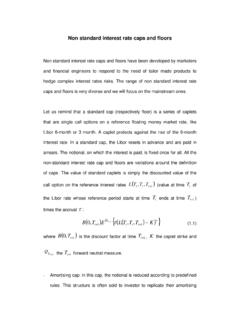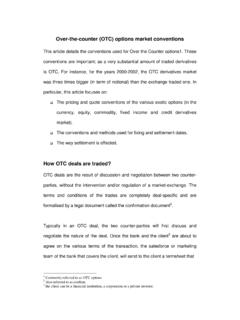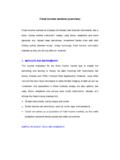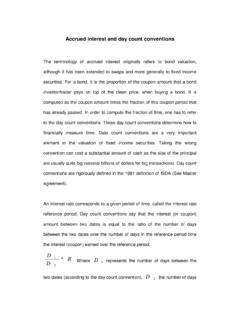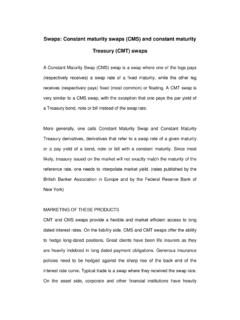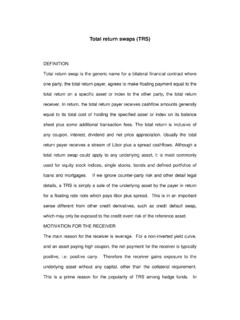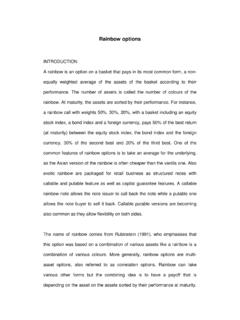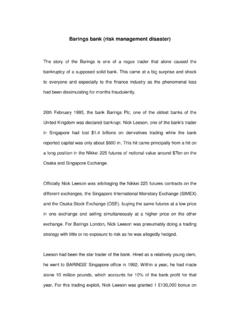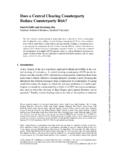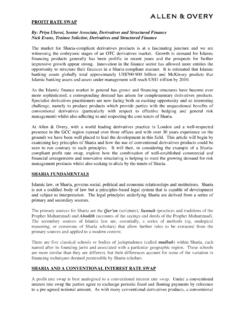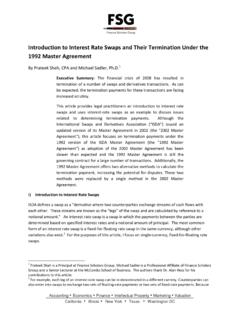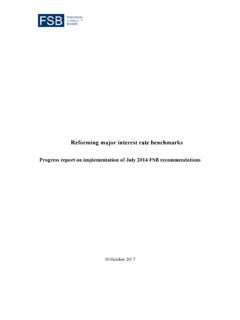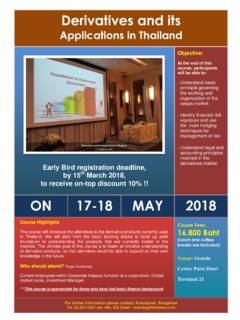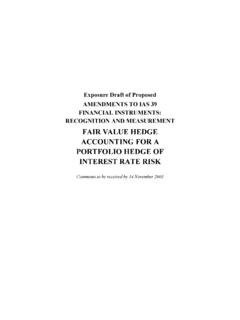Transcription of Delta risk on interest rate derivatives - Eric Benhamou
1 Delta risk on interest rate derivatives The concept of Delta risk on interest rate derivatives is a generalization of the traditional one of a single asset option. However, contrary to single asset derivatives , fixed income derivatives are derivatives depending on a variety of instruments, used in the determination of the interest rate curve, rather than a single asset. The Delta risk measures precisely the risk associated with the shift of the interest rate curve. Because there are many ways of shifting the interest rate curve, many different deltas can be computed. The most common ones are the following: DV01: Parallel shift of the interest rate curve.
2 In this scenario, all the market instruments used to construct the interest rate curve are bumped by one basis point (Futures needs to be bumped in the opposite direction as they share opposite convention to other market instruments). This is often referred DV01, (initially referring to dollar value of 01 basis points extended without changing names to other currency), and PV01 present value of 01 basis point, also referred to as PVBP. Implicitly, this approach assumes a na ve parallel evolution of the interest rate curve. Full Delta : Individual shift of the market instruments. In this Delta definition, one calculates as many deltas as there are market instruments.
3 Each Delta corresponds to the impact of the change of the market quote of one market instrument. Taking for the short end of the curve spot overnight and money market rates , futures and swaps for longer maturities does standard construction of the interest rate curve. This Delta is the most precise one as it isolates each market instrument impact. It can also be used to derive roughly all the other more compact Delta risks . This is why this is the one used by trading desks to compute their risk sensitivities on interest rate derivatives . Bucket Delta : Shift of certain section or buckets of the interest rate curve.
4 In this Delta definition, one regroups the different part of the interest rate curve into different sections, like for instance the short term money market instruments, the futures up to 2 years, swap rates up to 5 years, swap rates up to 10 years, and other. Bucket Delta measures the impact of shifting the rates of a given bucket by one basis point, keeping the other buckets unchanged. In this Delta , the risk profile is aggregated according to the definition of the buckets. Factor Delta : Shift of factors obtained after a factor analysis of the interest rate curve. The most common factor Delta is to use a principal component analysis.
5 Other factor analysis can be based on equilibrium models (model used for relative value). In this Delta , one calculates the impact of shifting the different factors. If the factors are obtained by pca, the first factor risk will approximately corresponds to a parallel shift of the interest rate curve, the second one of the twist of the curve, and the third one of the convexity of the interest rate curve. The bucket and factor risks are very useful to give a more condensed and quick overview of the risk. They help the traders understanding what to do if he wants to hedge partially his risk, taking for instance only a few points of the curve (see table 1 for an example of the various interest rate risks ).
6 Like for standard Delta , the risk is mainly computed numerically by bumping the various instruments. And like for the Delta of equity derivatives , the risk can be one or two sided: In one-sided risk, the Delta is computed as the difference of value between the initial portfolio and the one after the up bump. In two-sided risk, the Delta is computed as half of the difference of value between the portfolio after an up bump and the one after a down won bump. Standard practice is to do two-sided risk in order to include some convexity in the Delta as well as to use the fact the two-sided risk computation provides also all the computation for the gamma.
7 Delta is f ( x + ) f (x ). approximated by = ( ). 2 . f ( x + ) 2 f ( x ) + f (x ). while gamma is approximated as = ( ). 2. For interest rates derivatives , another important element of the interest rate risk is called reset risk. This risk shows the impact of the change of one market instrument on the resets of deals. Often, a report is generated which states which deals should have resets in the forthcoming weeks, with the notional amount of each trade on which there will be a reset. When computing overnight risk, it is also important to take into account the proper ageing of the trades and to compute in a sense a forward interest rate Delta risk.
8 Since the computation is done at the close of the trading day and is used the next day, one needs to account for the elapse of one business day. General industrial risk infrastructure used by investment banks is often built in a general way to support the following features: Fast computation of the risk, using multi-threading and distributed computing across a pool of computers. A server is responsible to distribute the various computations among the computing resources. Scalability of the risk engine in terms of risks scenarios: ability to specify various risk scenarios with configuration scripts specifying the market instruments to bump and the various operations to do on the portfolio.
9 Robustness of the risk engine: risks deal by deal with result saved on the fly, with deals with error flagged out, proper handling of exceptions and errors, so that the risk engine is not stopped by breaking trades, ability to rerun the risk, using previous results or flushing out pre-stored results, ability to select some trades and rerun the risk only on these trades and to aggregate with the rest of the portfolio. Below is given an example of the Delta interest rate risk for a given portfolio. As one can notice, this Delta risk includes some par instruments like money market and swap rates and some instruments that would settle in the future like futures.
10 In fact, one can express the risk in terms of only par- rates or in terms of forward rates . The transformation between one basis to the other is done by a matrix rotation between the basis of forward rates to the one of par and vice versa. The design of a general risk report engine should at least include the following points: Output function: this piece of code is responsible for writing to a specific output (a file, a database, a log), the various computation of the risk Initialisation function: before computing the risk, this piece of code is responsible for initialising correctly the environment, for instance take the correct market data, set the pricing date to the specific one.
